Paradox Labs Stripe Payments for Magento 2

In ecommerce business, website security and protection of sensitive data are the top issues. Today, we want to talk about the Stripe payment gateway and how you can integrate it in your store with the help of the Paradox Labs solution.
Stripe is a powerful payment gateway providing merchants and customers with the set of features that optimize payment procedures and guarantee safe processing of confidential cardholder data. The Paradox Labs Stripe Payments module for Magento 2 provides online stores with Stripe integration. With the extension, store owners improve the user experience by allowing customers to save their credit cards and do the checkout in one click. All sensitive data is stored on the Stripe server, which brings the security of ecommerce sites to a new level and builds customers’ trust.
Below, we look closer at the benefits that the Magento 2 Stripe payment module brings to merchants and customers, and describe how it functions in the backend and frontend.

Table of contents
Features
- Advanced stored card functionality;
- Credit cards management in the customer account;
- Admin control over customers’ saved payment info;
- Order placement from the Magento Admin;
- Multiple invoices;
- Partial refunds generated in the backend;
- Stripe Elements fields on the payment form;
- PCI compliant payment gateway with PCI SAQ-A security;
- Confidential cardholder data is stored on the Stripe server;
- Increased security with Card Verification Number (CCV) and Address Verification (AVS);
- Multiple stores support;
- Compatibility with Paradox Labs Adaptive Subscriptions;
- Magento API support.
By installing the Stripe Payments extension on your store, you can provide your customers with an option to save their credit cards and reuse them for future orders. This way, the checkout process becomes faster and more user-friendly since customers don’t have to enter their card details every time they shop on your website.
Moreover, customers get control over their payment data. The module adds a tab in the customer accounts where they can view the list of their saved credit cards, as well as update and delete existing cards. Also, users can specify the details of a new card and save it for future use when placing an order. This feature also speeds up the checkout process since your clients can quickly fill in the payment form and check out.
Besides bringing obvious benefits to customers, the stored card functionality streamlines order management for your admins. The admin panel provides the same features that are available on the frontend. Thus, Magento admins can manage stored payment info and use it for placing orders on behalf of customers in the backend. The Magento 2 Stripe module also enables admin users to efficiently manage multiple invoices and generate online credit memos for the partial refunds.
As for improved user experience, we should say a few words about the usage of the unified Stripe Elements fields instead of separate ones on the payment form. With this feature, users have a single input for credit card details that flows automatically from one field to another. Input fields have the same format as it appears on a credit card. If wrong information is entered, customers will immediately see a message warning them about the issue, due to the real-time data validation. Besides, the look of the credit card info fields can be customized to match a website theme.
As for the security concern, the Paradox Labs Stripe integration provides store owners with the required functionality to keep sensitive data safe and protect a web store from malicious attacks. Using Stripe Payments, merchants don’t store confidential payment details on their servers, as all entered credit cards data is sent directly to the Stripe server using TLS encryption. Stripe creates a token which replaces the actual data and is used by a merchant on his site. Thus, not any third party gets access to your clients’ sensitive data, while customers don’t experience any change in their shopping experience since they don’t have to leave your store for payment transaction processing. As a result, you gain customer loyalty while reducing your work related to handling payment transactions.
It is also necessary to mention that the Magento 2 Stripe payment module is PCI compliant and helps merchants to comply with PCI SAQ A eligibility requirements. Furthermore, Stripe Payments adds a security layer to transactions processing thanks to the credit card number verification and billing address validation functions.
Backend
First, let’s see how to configure the general settings of the Magento 2 Stripe module. Note that you should have an active Stripe Merchant account to accept payments via Stripe.
Configuration settings can be found under Stores -> Settings -> Configuration -> Sales -> Payment Methods -> Stripe. Here, you can view the version of the Stripe module currently installed on your website and the result of the API test. To display Stripe as a payment method on your storefront, enable the extension. Next, you can change the title of the Stripe payment gateway that will be visible at the checkout and on the order status pages. As for the following two fields, you can find your Public API Key and Secret API Key values in your Stripe account dashboard. Then, select a payment action depending on how you want to capture payments: immediately on the order placement or after invoice generation. Also, set the new order status (Pending, Processing, Suspected Fraud, or On Hold) and decide whether to display the “Powered by Stripe” badge at the checkout and pick its design.
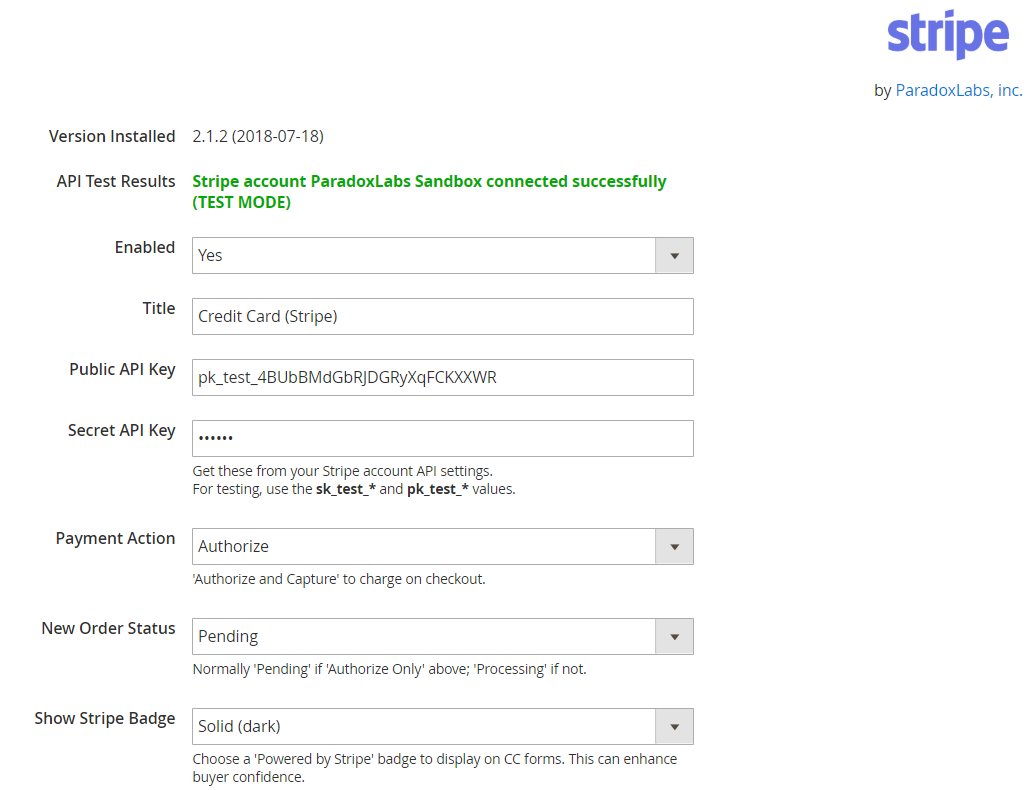
The Payment Settings section lets you decide whether to give customers an option to save or not a credit card they use at the checkout in their accounts. Next, define from which countries you want to accept Stripe payments, specify the minimum and maximum value for the order total to make Stripe available for payment, and set the sort order.
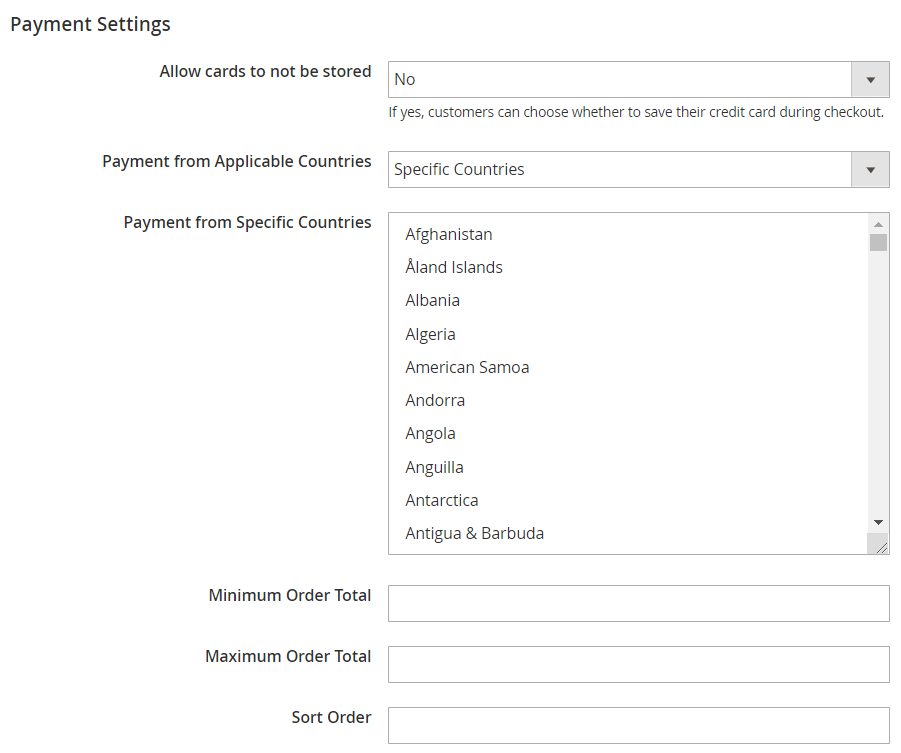
In Advanced Settings, the Element Style area lets you set specific keys to change fonts and colors of credit card input fields on the frontend. In Transaction Descriptor, you can create a custom text for credit card statements. Here, you can also enable the “Reauthorize on Partial Invoice” and “Verify SSL” functions.
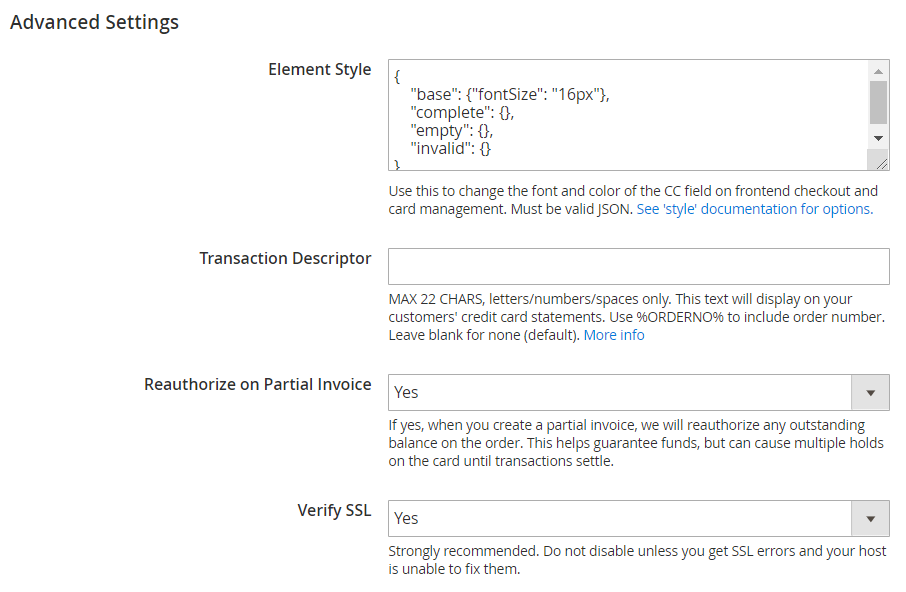
When creating an order instead of a customer in the backend, Magento admins can use customers’ stored cards in the Payment Method, as well as add and save new cards here.

On the order view page, admin users can check the details of the payments for the placed orders.

The Transactions tab of the order view page includes the full history and raw data of the transactions processed by Stripe.

Admin users can also view customers’ saved credit cards and their details under the Payment Data tab on the customer information page. You can edit and delete existing cards, as well add new ones for future usage.
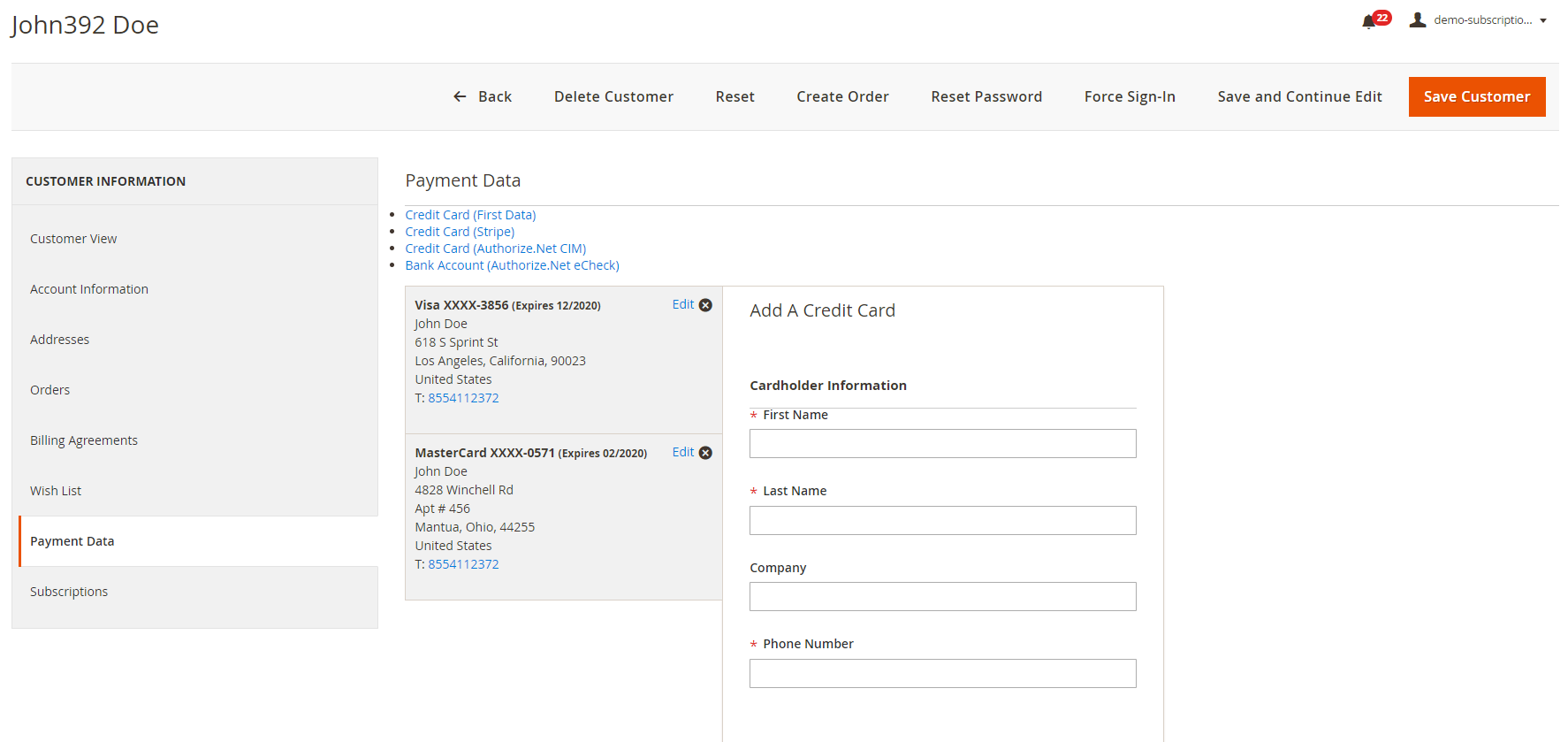
Frontend
After you install the Stripe Payments module, the option to pay using a credit card via Stripe will become available at the checkout. On the payment form, customers can select one of the cards they used before for purchases on your store and saved in their account or add a new card. Note that when choosing from the stored cards, the most recent one is selected by default. As we’ve mentioned above, the payment information on the form is presented using standard Stripe Elements, allowing customers to enter payment details in one stream. In the credit card info fields, separators are entered automatically, and the module detects the card type.
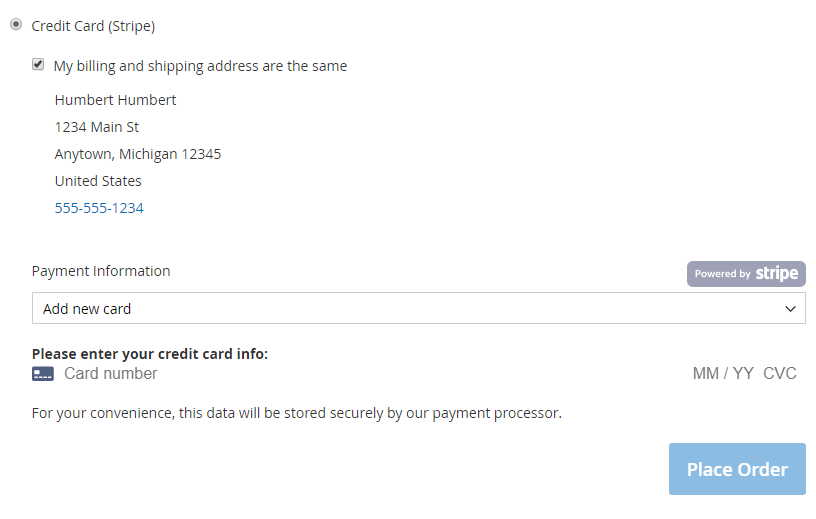
After placing an order, customers can view the payment details on the order status page under the My Orders tab.
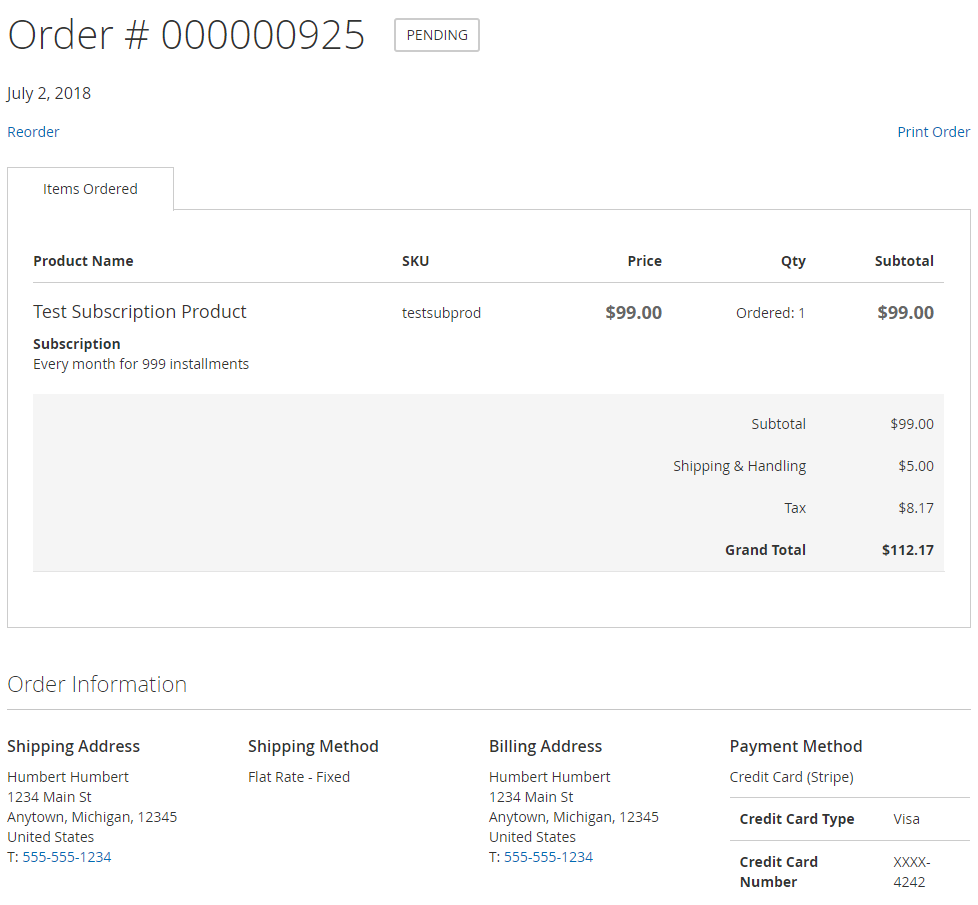
If a customer navigates to the My Payment Data tab, he or she will open the page where they can manage their credit cards. Here, it is possible to view, edit, and delete saved cards. Another possibility here is adding a new credit card and keeping it for future use.

Final Words
As you see, Stripe integration brought by Paradox Labs significantly increases the security of your online store and provides all the necessary features to use Stripe payments in the most convenient way. The stored cards functionality makes checkout user-friendly and builds trust to a store, as well as helps Magento admins efficiently manage customer details and orders.
The price of the Magento 2 Stripe Payments module is $279, and you can buy it by following the link below:









